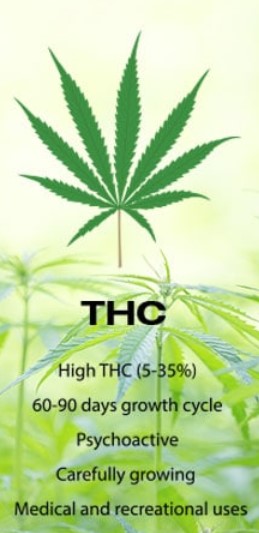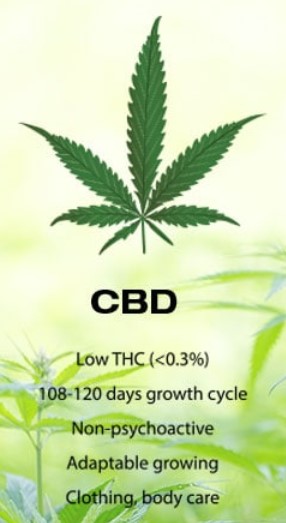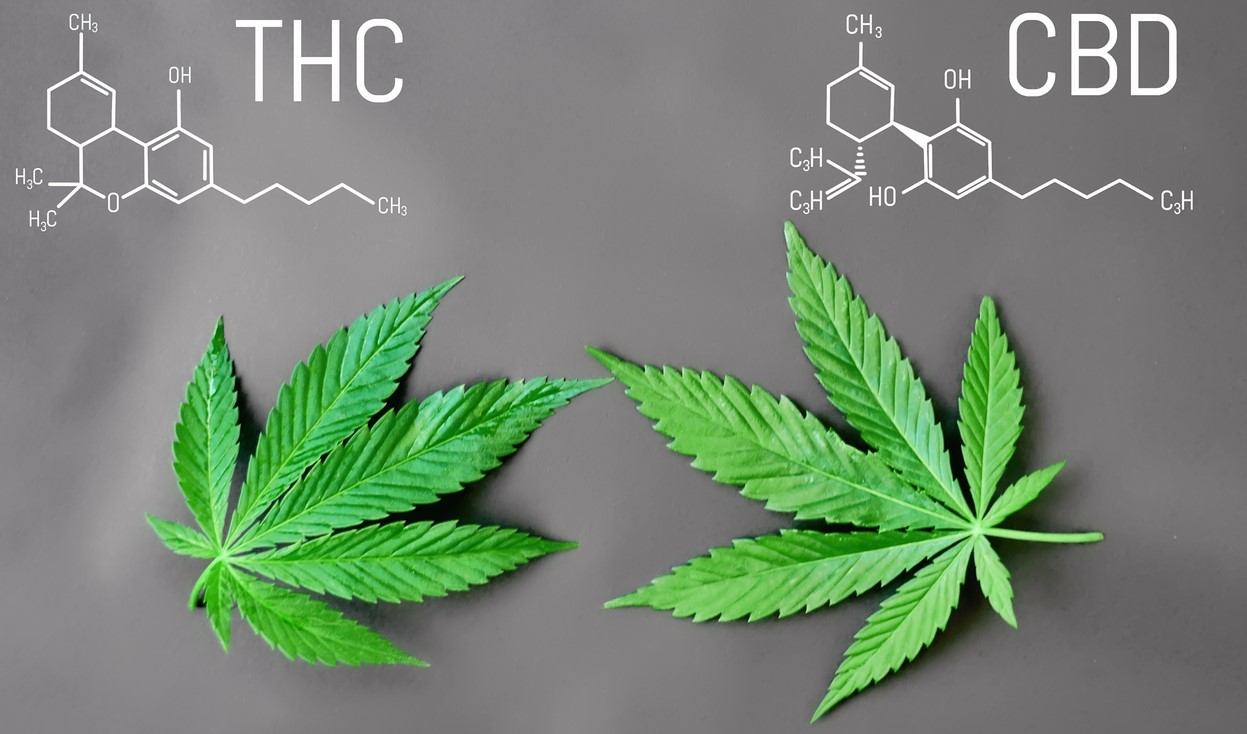According to current knowledge, there are over 100 chemicals in the cannabis plant. Cannabidiol (CBD) and tetrahydrocannabinol (THC) are two of the most plentiful and well-known compounds. Each cannabinoid has its own set of features and can produce varied effects on the body.
The most apparent distinction is that THC makes you feel good, whereas CBD does not. Furthermore, while CBD can be extracted from the cannabis plant, there are legal issues surrounding where it may be obtained due to its illegality.
Hemp and Cannabis – What’s the Difference & What Can They Do for The Body?
Cannabis and hemp are two different species of the cannabis plant, but they share a single legal distinction. Hemp has less than .3 percent THC content, whereas cannabis has more than that.
Hemp and cannabis utilize the same endocannabinoid system (ECS) in the human body, which controls their effects. The endocannabinoid system (ECS) is made up of receptors and endocannabinoids that interact with them. These work together to have an impact on a variety of vital functions, including pain, hunger, sleep, and more.
Cannabis is also rich in various compounds that are beneficial to the human body, such as cannabinoids, terpenoids, and flavonoids. THC and CBD are by far the most common of these chemicals with a lot of research devoted to them. But what exactly are they, how do they work, and why do they vary from one another?
CBD & THC – The Superstar Cannabinoids
To a great extent, cannabis was associated with getting high until rather recently, so the focus was mostly on THC. Scientists have lately discovered CBD and other cannabinoids, hinting that another avenue for researching marijuana’s therapeutic benefits opens up. Both THC and CBD are cannabinoids found in the cannabis plant.
What is THC & How Does It Work?
THC, or tetrahydrocannabinol, is the most essential and well-known component in the cannabis plant. It is what makes people high. While a high-THC variety will undoubtedly alter your brain, it may also have therapeutic advantages that are frequently overlooked.

When THC enters, it activates neurons and generates dopamine in the brain. THC binds to cannabinoid receptors in the brain, which have a variety of affects. Some THC strains provide you with a surge of energy and imagination, while others give you a soothing feeling as the high takes control of your body. Within 10 minutes, highly potent cannabis strains can cause an impact. The following are some examples of THC’s most common side effects:
- Increase in appetite
- Drowsiness
- Analgesic
- Relaxation
- Euphoria
What is CBD & How Does It Work?
Cannabidiol (CBD) is a cannabinoid that does not cause intoxication and is frequently utilized to cure illnesses since it has no “high.” While scientists investigate how CBD functions in the body, studies indicate that it interacts with the ECS. CB1 and CB2 are two of the main cannabinoid receptors found in the ECS. The CB1 receptors are mostly concentrated in the brain and have an essential function in memory, sleep, mood, eating habits, pain sensation, and other activities.
Cannabidiol (CBD) has two types of receptors, CB1 and CB2. The endocannabinoid system, which is made up of cannabinoid receptors and endocannabinoids, controls pain, inflammation, mood, memory, hunger, pleasure movement problems like Parkinson’s disease tremors), depression. THC binds to both types of receptors but CBD activates them indirectly by increasing the amount of endocannabinoids in the body. CBD also inhibits natural endocannabinoid breakdown. Here are a few instances where CBD can aid you:
- Anti-anxiety
- Anti-convulsant
- Neuroprotective
- Antioxidant
- Anti-inflammatory
THC – Why the High?
When it comes to cannabis’ intoxicating effects, we must concentrate on CB1 receptors in the brain and nervous system. THC binds strongly to CB1, whereas CBD does not. Because THC is shaped like a plug – i.e., fits snugly into a CB1 receptor socket – it activates these receptors effectively.
Cannabidiol (CBD) is another cannabinoid that has been studied for its anxiolytic effects. THC, the most common cannabis ingredient, binds to CB1 receptors in a similar way as CBD does. Furthermore, it somewhat mimics the ‘bliss molecule’ called anandamide, which is a naturally occurring endocannabinoid. The fact that THC resembles anandamide implies that when it binds to CB1 receptors, it contributes to the euphoric sensations associated with cannabis.
Cannabidiol (CBD) is a poor match due to its CB1 antagonist nature. It actually inhibits the CB1-activating capabilities of THC. CBD, in a nutshell, means that THC’s mind-altering effects are reduced. You might feel dizziness or euphoria if you consume cannabis with 22% THC content, for example. The psychoactive properties as well as anxiety will be decreased if it has 8% CBD and 22% THC.
CBD vs. THC: Chemical structure
Cannabinoids, such as CBD and THC, have the same chemical structure: 21 carbon atoms, 30 hydrogen atoms, and two oxygen atoms. The varying effects on your body are due to a tiny variation in how the atoms are positioned.
Cannabinoids interact with your endocannabinoid system in a similar way to CBD and THC. They may bind to your cannabinoid receptors as a consequence of their chemical similarity.
The effect of the interaction on neurotransmitter production in your brain is quite apparent. Neurotransmitters are chemical messengers that link neurons and have functions in pain, immune function, stress, and sleep, among other things.
CBD vs. THC: Psychoactive components
Despite their comparable chemical makeup, CBD and THC do not result in the same psychotropic effects. CBD is psychoactive; however, it does so in a way that differs from THC. It doesn’t give you the same sense of euphoria that THC does. CBD has been proven to help with anxiety, sadness, and epileptic episodes.
The primary psychoactive component in cannabis, delta-9-tetrahydrocannabinol (D9-THC), binds to cannabinoid receptors in the brain. D9-THC engages CB1 receptors in the brain, generating a euphoric high. Because CBD has little affinity for CB1 receptors on its own, it needs THC to connect to those receptors and aid decrease some of the negative psychotropic effects of THC (elevation and sedation).
CBD vs. THC: Legality
The federal government has a hands-on approach to cannabis policy in the United States. Under federal legislation, CBD is still classified as a Schedule I drug. Although hemp has been removed from the Controlled Substances Act, CBD remains on the DEA’s and FDA’s Schedules I list (DEA).
However, 33 states plus the District of Columbia have decriminalized or legalized cannabis-related legislation, allowing for medical marijuana with a high THC concentration. Several jurisdictions have now made the usage of THC and cannabis for recreational purposes legal. CBD should be able to be purchased in anyplace where cannabis is permitted for personal or therapeutic use.
Before attempting to buy CBD or THC-infused products, you should understand your state’s limitations. If you have cannabis-related goods in a state where they’re prohibited or don’t have a medical prescription in states where the items are legal for medical use, you may face legal problems.
CBD vs. THC: Medical benefits
CBD and THC have many medical benefits in common. They can assist with a variety of ailments. CBD, on the other hand, does not produce the same euphoric effects as THC. Some people may prefer CBD over THC because to this side effect.
In June 2018, the U.S. Food and Drug Administration (FDA) gave permission to Trusted Source Epidiolex, the first prescription drug containing CBD, which is used to treat rare and difficult-to-control types of epilepsy. (Epidiolex is not yet licensed for any of the other conditions listed below.)
CBD is used to help with other various conditions, such as:

- seizures
- inflammation
- pain
- psychosis or mental disorders
- inflammatory bowel disease
- nausea
- migraine
- depression
- anxiety
THC is used to help with the following:
- pain
- muscle spasticity
- glaucoma
- insomnia
- low appetite
- nausea
- anxiety
CBD vs. THC: Side effects
Even when taken in high dosages, CBD is a relatively safe medication. According to StudyTrusted Source, any CBD adverse effects are most likely the result of CBD interactions with any other medicines you’re taking.
THC causes temporary side effects, such as:
- increased heart rate
- coordination problems
- dry mouth
- red eyes
- slower reaction times
- memory loss
- anxiety
CBD’s side effects may include:
- appetite changes
- fatigue
- weight loss
- dizziness
- diarrhea
The adverse effects mentioned here are caused by the drug’s psychotropic properties. Both are not deadly. Marijuana dependence has been linked to long-term mental problems in some people, however. This is especially true for teenagers who ingest a lot of THC, although there isn’t enough evidence that cannabis use causes psychiatric disorders such as schizophrenia.
CBD vs. THC: Drug testing
Cannabinoids, such as THC and CBD, are stored in the body’s fat. They may be detected for days or weeks after usage on drug tests. nNot every drug test is able to detect CBD, however there are options that are CBD-sensitive. Marijuana use might show up on a screening due to chemicals linked to THC;
Although hemp does not contain any cannabinoids, it can produce THC in addition to CBD. Even if you haven’t used it, a test for THC may come back positive. It’s important to remember that products labeled as “THC-free” might actually have traces of THC.
Why do people talk about THC content in CBD oil if THC and CBD are two different compounds?
Cannabinoids are chemicals in cannabis that interact with cannabinoid receptors. The two most well-known cannabinoids in cannabis are CBD and THC. Both cannabis and hemp generate CBD and THC. Cannabis has a greater concentration of THC than hemp, according to a reputable source. According to “THC,” a trusted source, the average amount of THC in today’s cannabis strains is approximately 12 percent.
CBD & THC – Better Together?
The entourage effect occurs when cannabinoids, flavonoids, and terpenes from a cannabis plant are combined. The entourage effect is what causes this phenomenon; together, cannabis’ components may result in unexpected benefits that no single component can provide alone.
The efficacy of cannabis to treat chronic pain is a perfect example. THC alone can effectively handle severe discomfort, but CBD can assist with anxiety symptoms that may come with chronic disease. CBD’s usage in the treatment of sleep disorders is on the rise. Depression, arthritis, anxiety problems, and headaches have all been shown to respond favorably to a combination of THC, CBD, and terpenes therapy.
Legal Status
THC
Uruguay was the first country in the world to legalize marijuana for recreational use when it did so in 2014. In Canada, Bill C-45 received approval. This legislation allows people to possess up to 30 grams of cannabis. It also permits licensed businesses to sell cannabis. Cannabis is illegal at a federal level in the United States. However, it is legal for recreational purposes in certain states.
CBD
The cannabis plant contains an active chemical called delta-8-tetrahydrocannabinol, or THC, which is classified as a Schedule I drug by the US Controlled Substances Act. It is banned in all 50 states, however it may be acquired if the hemp source has a THC level of less than 0.3 percent.
Final Thoughts on CBD Vs. THC
Because of the Farm Bill’s passage, CBD has become increasingly accessible. CBD products, including oils and capsules, are now available to customers. In early studies, CBD appears to help with a variety of issues. CBD, in fact, may assist those living with Parkinson’s disease manage their symptoms. Future research may reveal even more about CBD and how it can be utilized.
Cannabidiol (CBD) has been found to help with a range of illnesses, while THC (delta-8-THC) has been established to aid with a variety of maladies. CBD, on the other hand, has been discovered to aid with a number of health issues. In one research, THC was linked to improved symptom alleviation and mitigation.
According to the research, greater amounts of THC were linked with more powerful effects, although there was no apparent link between the amount of CBD and symptom alleviation. Despite its potential advantages, THC has an apparent impact on perception. Its psychoactive profile may be a disadvantage for some people.
Cannabinoids, such as CBD and THC, can help with a number of illnesses when used together. One possible explanation for the efficacy of whole-plant cannabis is CBD’s capacity to counteract THC’s psychotropic effects.
Cannabinoids, such as cannabidiol (CBD) and tetrahydrocannabinol (THC), have medical uses. They’re also both considered safe, but it’s important to be aware of any potential side effects or drug interactions. Before using it, talk with your doctor or a knowledgeable cannabis or CBD expert to ensure that you understand the dangers involved.
The more we learn about how each chemical may benefit people, the better we’ll be able to discuss and evaluate it as the number of CBD and THC studies increases.
